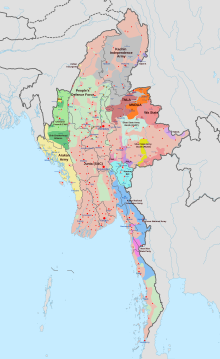Chinland
State of Chinland | |
|---|---|
| Anthem: Chin National Anthem | |
 Location of Chinland (dark green) | |
| Status | Autonomous self-governing federal polity |
| Capital | Camp Victoria[citation needed] |
| Official languages | Burmese Hakha Hualngo |
| Regional languages | Daai Falam Hakha Hualngo Lautu Mara Sizang Tedim Zanniat Zou Zophei |
| Ethnic groups | Chin Myanmar Mizos |
| Demonym(s) | Chin |
| Government | Provisional government |
• Chairman of Chinland Council | Pu Zing Cung |
• Prime Minister | Pu Pa Thang |
| Legislature | Chinland Council |
| Establishment | |
• Chin Hills Regulation Act | 13 August 1896 |
• Chin Forum Initiative | 1998 |
• Chinland Council | 13 April 2021 |
• Chinland Constitution | 6 December 2023 |
| Area | |
• Total | 36,018.8[1] km2 (13,906.9 sq mi) |
| Population | |
• 2014 census | 578,801[2] |
• Density | 16/km2 (41.4/sq mi) |
| Currency | Kyat (K) (MMK) |
Chinland, officially the State of Chinland, is a self-governing polity in Southeast Asia. Its claimed territory encompasses Myanmar's Chin State.[3] It controls nearly all of the Chin State in western Myanmar, along the borders with Bangladesh and India. The Chinland Council, the ruling authority of Chinland, stated that one of its main goals is the formation of federal union, where Chinland will become an autonomous federal unit within a future federal Myanmar once the State Administration Council military junta has been overthrown.[4]
History[edit]

The state was established following the ratification of the Chinland Constitution on 6 December 2023 by the Chin National Front (CNF) and local administration organisations, establishing the Chinland Council as its governing body and changing the former name of Chin State to Chinland.[4] The constitution aimed at creating a nation state for the Chin people following the principles of self-determination with a "coming together federal vision", i.e., a bottom-up approach for the establishment of future federal union in Myanmar.[3][4]
The Chinland Council, composed of 27 CNF members, 14 MPs and 68 members of local administrations, received the support of 14 of the 17 recognised local administration organisations in Chin State, with the exception of Falam, Tedim and Mindat.[3][4]
Governance[edit]
Chinland's government is divided in three branches — executive, legislative and judiciary — overseen by the Chinland Council, expected to fully establish the three branches by January 2024.[4][needs update] The executive is expected to include 15 ministries, among which ministries for Defense, Home Affairs, Foreign Affairs and Immigration.[3]
The Chinland Constitution also establishes the Chin National Army as the state's only national army. Nonetheless, local administrations still maintain their own armed forces, most of them as part of the Chinland Defense Force and organised in the Chin Joint Defense Committee.[3]
Administrative divisions[edit]

The townland and regional divisions of Chinland are as follows:[5][6]
- Daai
- Falam
- Hakha
- Hualngo
- Kanpetlet
- Lautu
- Matupi
- Mara
- Mindat
- Ngawn
- Paletwa
- Senthang
- Siyin
- Tedim
- Tonzang
- Thantlang
- Zanniat
- Zophei
- Zotung
Symbols[edit]
The flag used by the Chinland Council is identical to that of the Chin National Front, which differs from the Chin State's previous flag. It consists of three horizontal bands of red, white and blue, charged with two hornbills in the center.[4]
Status[edit]
While claiming to strive for a "federal democracy union", the constitution did not discuss Chinland's status with respect to Myanmar, leading to speculation about potential separatism.[3] However, the Chinland Council's constitution does explicitly state that a federal union is one of its main goals and that the Chinland Council and Government will work in coordination with the democratic National Unity Government, the National Unity Consultative Council, and other "federal units."[4]
Furthermore, some members of the previous Interim Chin National Consultative Council, established in 2021, have rejected the authority of the Chinland Council, fearing a ratification of the constitution would lead to the dissolution of the ICNCC.[3]
See also[edit]
- Wa State, another self-governing polity in Myanmar
- Chin National Front
References[edit]
- ^ "Union of Myanmar". City Population. Retrieved 10 April 2009.
- ^ Census Report. The 2014 Myanmar Population and Housing Census. Vol. 2. Naypyitaw: Ministry of Immigration and Population. May 2015. p. 17.
- ^ a b c d e f g "The First Chin-Written Constitution: A New Template For Self-Determination?". The Irrawaddy. 26 December 2023. Archived from the original on 26 December 2023.
- ^ a b c d e f g Tum Hmung, Zo; Indergaard, John (11 January 2024). "Chinland Council Established in Myanmar". Stimson. Retrieved 14 February 2024.
- ^ "Chin Community (Germany)". www.ccgev.de. Retrieved 25 March 2024.
- ^ Matamis, Joaquin (11 January 2024). "Chinland Council Established in Myanmar • Stimson Center". Stimson Center. Retrieved 25 March 2024.


